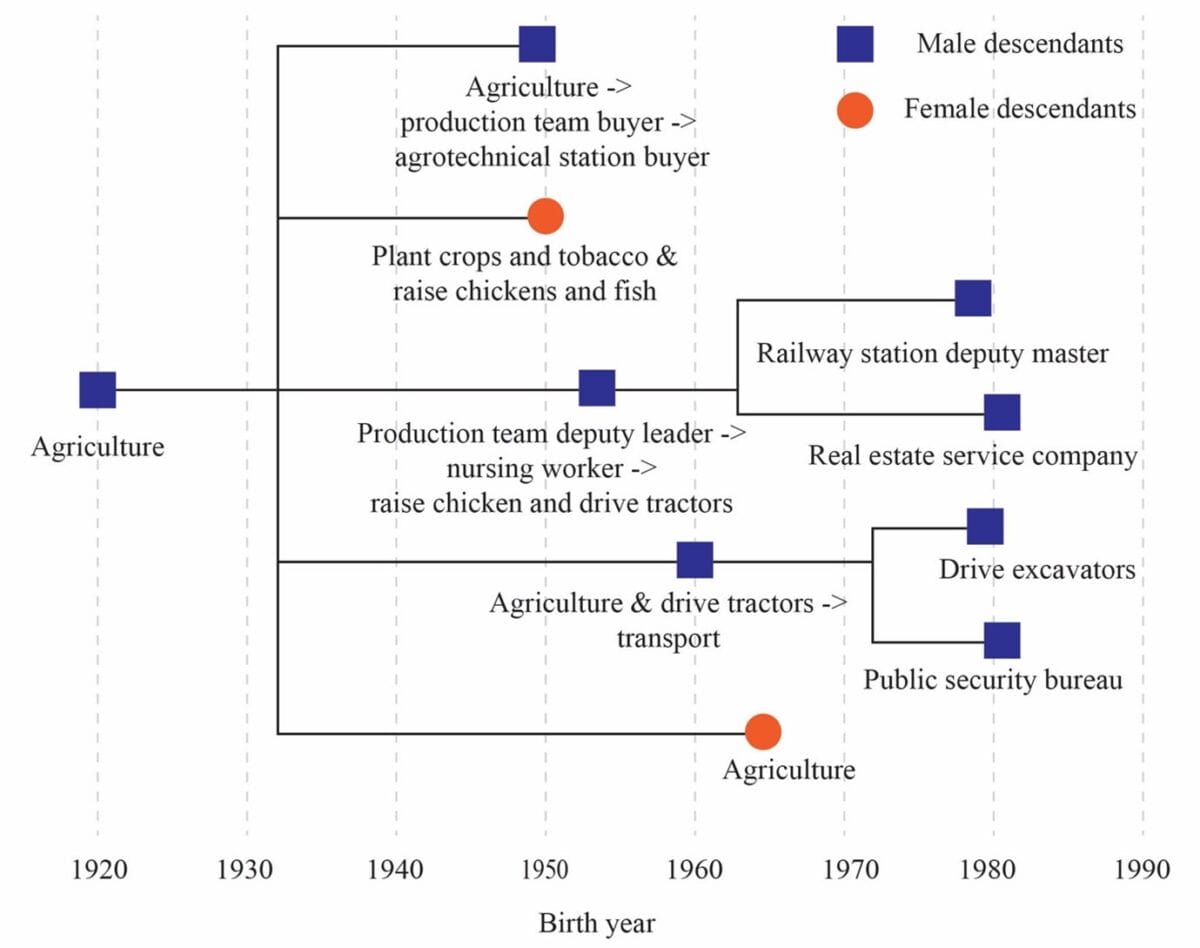The occupational structure of twentieth-century China: Evidence from lineage genealogies
In this post Ying Dai of University of Oxford discusses her ongoing research, supported by an EHS Carnevali Small Research Grant.
—
Occupational structure is essential for understanding the economic and social transformations of twentieth century China. However, reliable occupational data from censuses are only available from 1982 onwards. My earlier work has identified lineage genealogies (jiapu) as a new, reliable and consistent source of occupational data for twentieth-century China. Using this census-micro-data-like dataset with 210,383 occupational observations from 211 genealogies of lineages founded in the Yangtze Valley, I have demonstrated the representativeness of the genealogical occupational data at the macro-region level and showcased its unique value in illuminating long-term changes in by-employment (where individuals hold multiple occupations simultaneously) in industrialization, for which evidence is scarce worldwide.

Generously funded by an Economic History Society Carnevali Small Research Grant, I will be able to expand the geographical coverage of the genealogical occupational dataset. Specifically, the grant will allow me to collect and digitize around 160 genealogies with an estimated number of 150,000 observations from Fujian, Guangdong, Guangxi, and Hainan in Southern China. The expansion of the dataset will allow me to explore the following questions:
(1) What role did key cities play in China’s economic development in the twentieth century?
Shanghai has long been regarded as China’s gateway to modernity; Hong Kong served as the sole economic link between mainland China and the West from the 1950s until the late 1970s; and Shenzhen has been the pioneering city in China’s Reform and Opening-up. These three cities in southern China are fundamental to understanding China’s economic development during the twentieth century. This project will explore the roles of these cities in the national economy, their hinterlands, and in relation to each other by quantitatively reconstructing their occupational structures, the source locations of migrants into the cities, and the economic connections between them. I will integrate multiple sources, including lineage genealogies, population registers, and governmental statistics.
(2) How did different industries contribute to China’s economic development in the twentieth century?
Data from the Yangtze Valley suggest distinct patterns of development across various industries. Heavy industries witnessed a continuous increase in employment proportions for both men and women, whereas light industries exhibited greater fluctuations. Textile industries experienced the most thorough and substantial specialization, marked by a decrease in the proportion of by-employed workers; specialization in construction, transportation, and the production of food and drink, wooden products, and building materials progressed more gradually. This project will further explore how different industries contributed to China’s economic development by tracking their patterns of factory production, spatial concentration, and gender dynamics.
(3) How did China’s economic development unfold in different regions in the twentieth century?
Data from the Yangtze Valley suggests distinct regional occupational structures in the first half of the twentieth century, as well as notable similarities in the employment shares of construction and the tertiary sector from 1982 onwards. This project will expand the scope of analysis to include more provinces in China, and it will explore finer spatial units to deepen understanding of urban-rural differences and connections. The results will provide new evidence for debates related to the geography of China’s economic development, such as the central place theory, the dual economic model (advanced treaty ports versus unchanging rural areas), and the impacts of various regional development initiatives.
Besides occupational structure, lineage genealogies, with their contextualised and rich individual-level information, will allow for research on various aspects of the history of work in twentieth-century China, such as the gendered division of labour, the rise of urban wage labour, occupational changes over the lifetime, inter-generational occupational mobility, spousal and sibling collaboration in business, and marriage formation based on occupations. Genealogies also contain individual biographies detailing the experiences of a broad social spectrum. Combining the quantitative and qualitative evidence in genealogies will allow us to understand the working lives of twentieth-century China from the perspectives of both macro structures and micro experiences.
In the future, I aim to expand the dataset to the entirety of China where sufficient numbers of genealogies are available. The dataset will provide data infrastructure for interdisciplinary collaborations among researchers from history, economics, sociology, geography, gender studies, etc.
References:
Dai, Y. ‘By-Employment in the Yangtze Valley in the Long Twentieth Century: Specialization, Structural Change, and the Land Systems’. Economic History Review, 2025, pp. 1–28.
———. ‘Lineage Genealogies as a New Source for Researching the Occupational Structure of Twentieth-Century China: Tradition (Partially) Transformed’. Historical Methods: A Journal of Quantitative and Interdisciplinary History 58 (2025), pp. 54–79.
To contact the author:
Ying Dai
Faculty of History, University of Oxford
Cambridge Group for the History of Population and Social Structure, University of Cambridge

